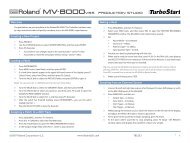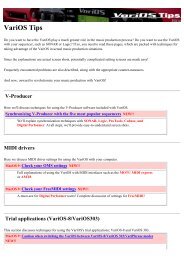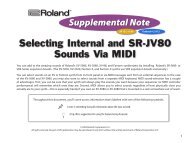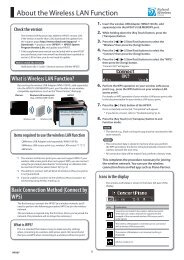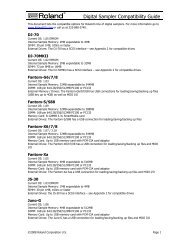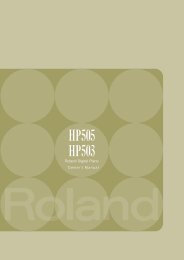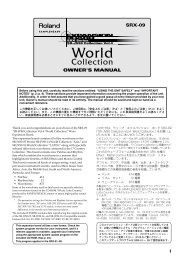You also want an ePaper? Increase the reach of your titles
YUMPU automatically turns print PDFs into web optimized ePapers that Google loves.
Chapter 3. Creating Your Own Sounds<br />
OFF-OUT:The LFO will be immediately applied when the<br />
key is pressed, and will begin fading out when the<br />
key is released.<br />
fig.3-40.e<br />
high (more)<br />
WG Pitch /<br />
TVF Cutoff Frequency /<br />
TVA Level / TVA Pan<br />
low (less)<br />
Delay (LFO Delay Time)<br />
Adjust the time from when the key is pressed (or released)<br />
until the LFO begins to take effect. (Refer to the diagrams for<br />
Fade Mode.)<br />
Fade (LFO Fade Time)<br />
Adjust the time over which the LFO rises to its full effect (or<br />
diminishes). (Refer to the diagrams for Fade Mode.)<br />
Offset (LFO Offset)<br />
Adjust the basic value of the LFO waveform upward or<br />
downward.<br />
LFO DEPTH 1:2<br />
key is<br />
pressed<br />
Delay<br />
Time<br />
key is<br />
released<br />
Fade<br />
Time<br />
These parameters adjust the way in which the LFO affects<br />
each parameter. Two values are displayed for each<br />
parameter. The left one is for LFO1, and the right one is for<br />
LFO2.<br />
Pitch (Pitch LFO Depth 1, 2)<br />
Adjust how much the LFO will affect the WG Pitch.<br />
TVF (TVF LFO Depth 1, 2)<br />
Adjust how much the LFO will affect the TVF Cutoff<br />
Frequency.<br />
TVA (TVA LFO Depth 1, 2)<br />
Adjust how much the LFO will affect the TVA Level.<br />
Pan (Pan LFO Depth 1, 2)<br />
Adjust how much the LFO will affect the TVA Pan.<br />
Depth<br />
■ Modifying Pitch (PITCH)<br />
The parameters in this group affect the WG Pitch of each<br />
Tone.<br />
PITCH<br />
Specify the basic pitch of each Tone.<br />
Coarse (Coarse Tune)<br />
Adjust the pitch in semitone steps (-4–+4 octaves).<br />
Fine (Fine Tune)<br />
Adjust the pitch in 1-cent steps (-50–+50 cents).<br />
* One cent is 1/100th of a semitone.<br />
Random (Random Pitch Depth)<br />
If you want the pitch of the Tone to change randomly each<br />
time the key is pressed, set the desired amount of pitch<br />
change here. If you do not want the pitch to change<br />
randomly, set this to 0. The value is in units of 1 cent.<br />
Keyfollow (Pitch Key Follow)<br />
This parameter sets the amount of pitch change that will<br />
occur when you move one octave on the keyboard. If you<br />
want the pitch to change 1 octave when the keyboard position<br />
rises 1 octave (as on normal keyboard instruments), set this<br />
parameter to +100. If you want the pitch to rise 2 octaves<br />
when the keyboard position rises 1 octave, set this parameter<br />
to +200. Negative (-) settings will make the pitch become<br />
lower as you play up the keyboard. If you want all keys of the<br />
keyboard to produce the same pitch, set this parameter to 0.<br />
fig.3-41.e<br />
Pitch<br />
+200<br />
+150<br />
+120<br />
+100<br />
+70<br />
+50<br />
+40<br />
+30<br />
+20<br />
+10<br />
0<br />
–10<br />
–30<br />
–50<br />
–70<br />
–100<br />
C2 C3 C4 C5 C6 C7<br />
Keyboard position<br />
Chapter 3<br />
PCH ENVELOPE (Pitch Envelope)<br />
These parameters determine how the Pitch Envelope affects<br />
the pitch.<br />
Envelope Depth (Pitch Envelope Depth)<br />
Adjust the amount of the Pitch Envelope. Higher settings<br />
will result in greater change. Negative (-) settings will invert<br />
the direction of the envelope.<br />
79





